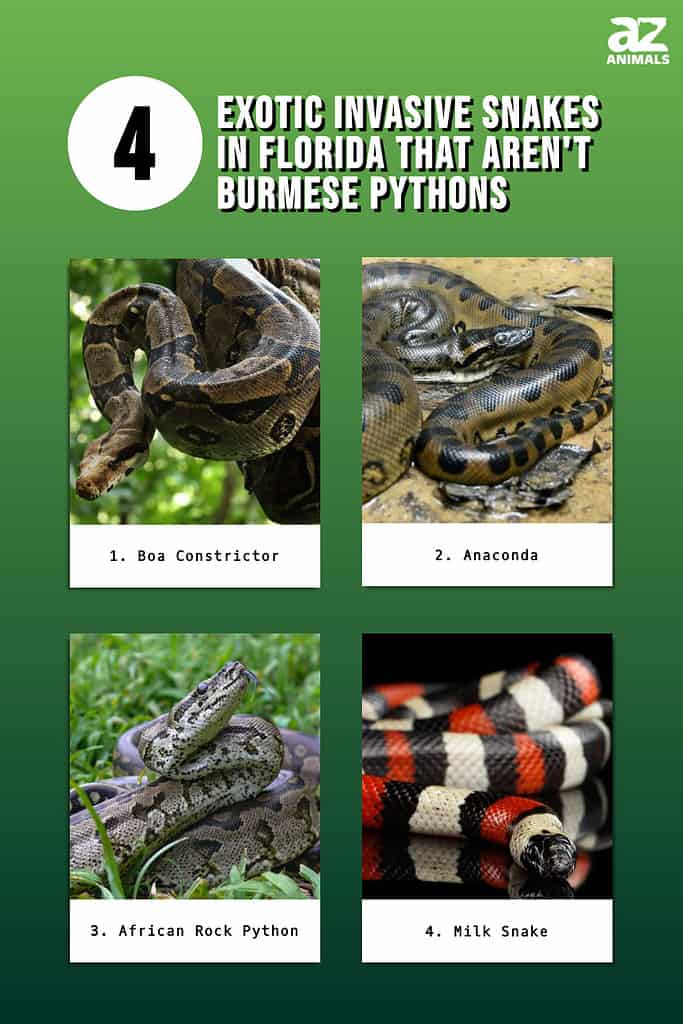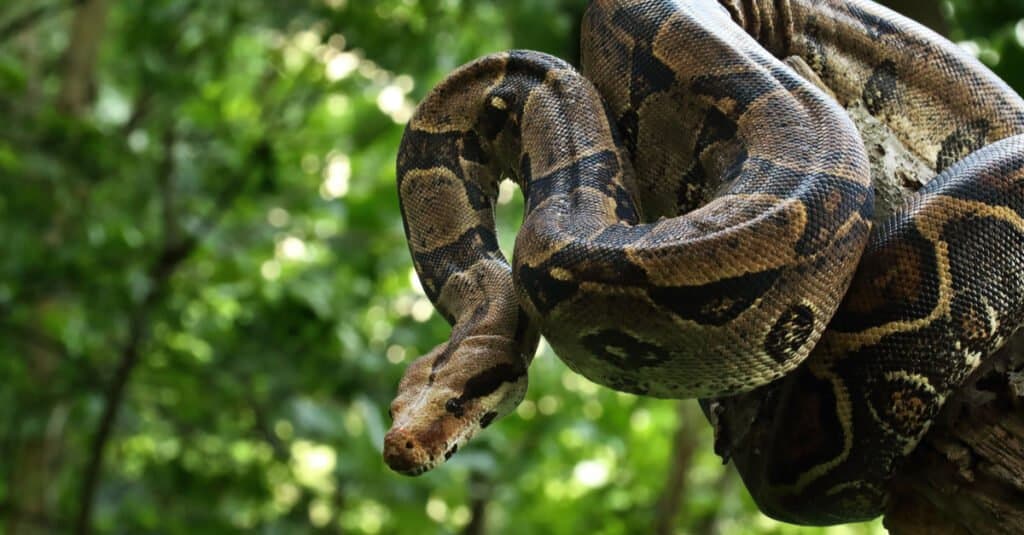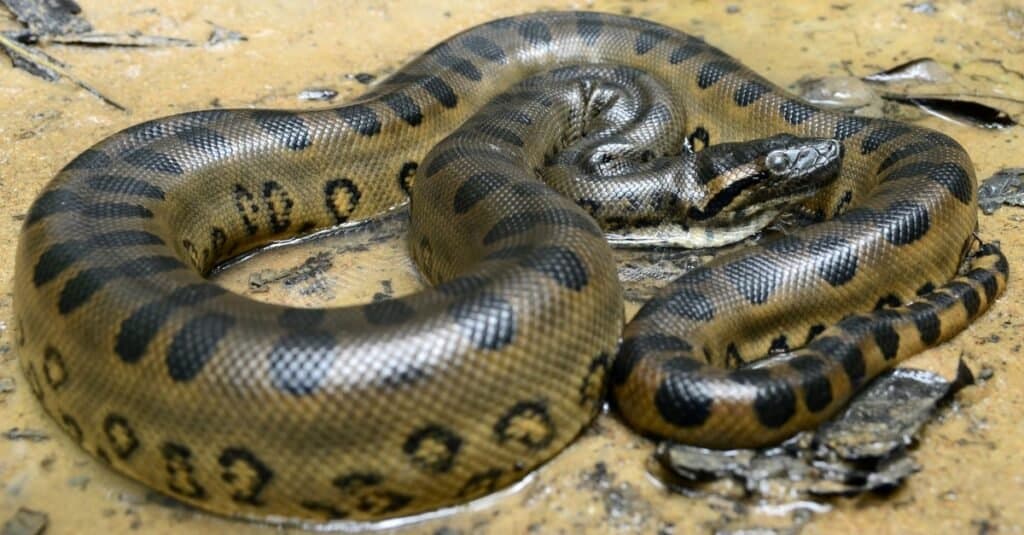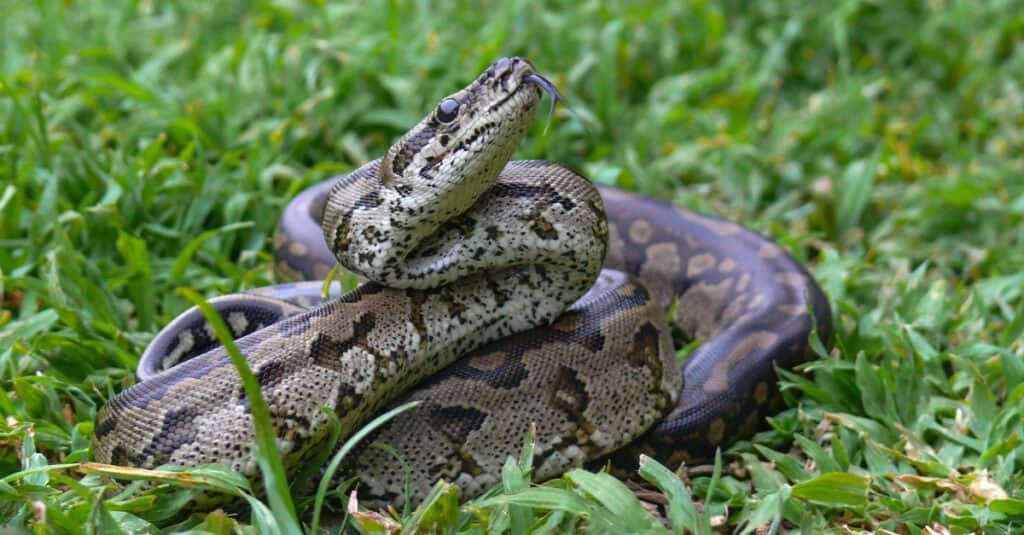Florida has an incredibly warm climate. It is thanks to this climate that so many species of reptiles call it home. Did you know that Florida is actually home to 46 species of native snakes? It doesn’t matter if you hate snakes — they are incredibly important to the ecosystem in Florida and throughout the world. Thanks to snakes, many rodent populations, which spread diseases to humans, are kept at bay. Moreover, many lizards are also great meals for many birds, alligators, snakes, and even certain mammals. However, not every snake that lives in Florida is good for the environment. Some invasive snakes in Florida are more trouble than good.

The Burmese python is one of the most well-known invasive species in the Floridian environment, but did you know that there are others? Several other invasive exotic snakes are pretty harmful to the natural ecosystem of Florida. Are you interested in learning about them? Learn about the exotic species that aren’t Burmese pythons and the type of havoc they wreak on the environment.
1. Boa Constrictor

Boa constrictors inhabit a wide range of habitats in Florida, including hammocks, rocky terrain, and swamps.
©Jan Hejda/Shutterstock.com
Since the 1970s, boa constrictors have become quite numerous in Florida. They are actually native to Latin America. Even though they have been introduced to various regions of Florida, they are only established in the Charles Deering Estate in Miami.
When you come across a boa constrictor, you can assume it’ll be anywhere between 10-116 inches. For those that don’t know, this is one of the largest snakes in the world, and it has a sturdy body to keep it going. You’ll immediately recognize them as they have “saddles” along their body and their color becomes reddish towards their tail. This snake is usually grayish brown, tan, light brown, or cream in color.
One of the most common ways boa constrictors make it out into the wild is through pet shops. They are often sold as pets; at times, they can escape or are released by their owners. Sometimes, tons of boa constrictors will be let loose at once. This usually happens when there is hurricane damage that occurs, such as Hurricane Andrew back in 1992 which damaged many facilities.
Researchers have noted that there is evidence that boa constrictors feed on tons of different rodents, which include both squirrels and opossums in Florida. Since they are one of the most powerful species of constrictor snakes, they can also feed on larger animals such as birds, lizards, and various mammals. As a result of their eating habits, several vertebrate species are at risk of being negatively impacted by these snakes.
2. Anaconda

Some consider anacondas to be among the planet’s most dangerous creatures.
©Patrick K. Campbell/Shutterstock.com
It has been reported that anacondas have been spotted living in Florida’s Everglades, which has shocked many people. Regarding dangerous animals, anacondas are one of the most dangerous in the world. It is believed that both green and yellow anaconda made their way into the Everglades and are now living alongside Burmese pythons and many other species of snakes. In terms of where they live, they are primarily found in bodies of water. This is because they can camouflage themselves well in the water. Researchers also believe that this is how the anaconda has stayed hidden for so many years in the state.
The anaconda was first spotted in Florida in 2003 around the Trail Lakes Campground. However, no one knows just how long this species has been living in the state. In addition, researchers are unsure how many anacondas live in the Everglades. However, female anacondas can produce up to 80 babies per year. Many animals have been introduced into South Florida unintentionally as well. This is why researchers are unsure of how they made their way into the Everglades.
This snake is also giant in size. They can grow to be up to 30 feet in length! Additionally, the green anaconda is also considered to be the heaviest snake in the world. This snake can sometimes even weigh more than 400 pounds.
Besides having olive green coloring along its sides, this invasive snake in Florida also has dark splotches along its back. Even though they’re not venomous, they can be quite deadly. This is why many people find it worrisome that anacondas have made a home out of the Everglades.
3. African Rock Python

The African rock python is a species of constrictor snake that is large and non-venomous.
©Chris Graf/Shutterstock.com
The African rock python is a large, non-venomous species among the constrictor snakes. It can grow up to 20 feet in length in its native range, but its average size in Florida is around 10 feet. Pythons from Northern Africa can be found in semi-arid and swamp habitats in their native range. Canals and agricultural areas are the best environments for them to flourish. Because they are a native African species, they are not supposed to roam freely throughout the Floridian ecosystem.
These species are considered invasive in Florida due to their impacts on native wildlife. The first reports of them in Florida date back to the early 2000s. There have been reports of them in Sarasota and Miami-Dade counties. In Florida, it is not protected except by anti-cruelty laws. This means landowners have the right to kill it on their property humanely. For identifying one, look for a large, stout-bodied snake with dark blotches that are bordered by black and white and are mostly continuous and irregular. There are often C-shaped markings on the front part of the body that transition to vertical bars on the sides of the body.
For safety reasons, African rock pythons usually stay well hidden in dense vegetation. When cornered, however, juveniles and adults will both strike rapidly. Their bites and constrictions are common when they are writhing and under pressure. Even so, these snakes are not aggressive; striking only comes when defending themselves. They are, however, more likely than Burmese pythons to bite if they feel threatened.
4. Milk Snake

Milk snakes in Central America are not venomous and can grow to over 70 inches in length.
©Seregraff/Shutterstock.com
Another invasive snake in Florida almost became a huge problem when it was discovered in the Everglades. Hikers making their way through the Mahogany Hammock Trail in Everglades National Park were startled when they came across a Central American milk snake. They immediately alerted the staff to the sighting. In good luck, the snake was captured by park staff and biologists from the U.S. Geological Survey Fort Collins Science Center.
Another great turn of luck is that it was only a single snake. This was a great relief for the park and the overall Everglades ecosystem that has been devastated by other invasive snakes in Florida. This is an excellent example of how easily an exotic species can go undetected in a non-native habitat and continue to flourish if not stopped.
In their native habitats, milk snakes are known to appear red, yellow, and black-banded. Many people think they are coral snakes that are the same colors. This is why they often get confused with each other. Central American milk snakes, however, are not venomous. They can also grow to be almost 70 inches in length. Since they are non-venomous, they are also often kept as pet snakes.
Nobody knows for sure how this snake got into the Everglades. However, the most popular guess by researchers is that it was unintentionally released into the wild. The milk snake is a carnivore, like other snakes, and it will eat both mammals and birds. If the snake finds itself in a more agricultural environment, it will feast on lizards, other snakes, snake eggs, mice, rats, and even bird eggs.
Sometimes they’ll even eat their deadly doppelganger, the coral snake. Their way of capturing prey is by constricting them. They wrap their bodies tightly around the prey until they prevent sufficient blood flow to the heart. Then they can easily swallow the prey up whole!
Other Reptiles Found in Flordia

The Eastern
glass lizard
, unlike a snake, has ear holes and blinks its eyes.
©iStock.com/Dan Rieck
Florida’s rich and varied ecosystems are home to a fascinating array of snake species. Florida is known for its marshy environment, perfect for many different types of reptiles. One reason Florida has so many amphibians is due to the illegal pet trade and the release of exotic animals into the wild.
With that said, here are some additional reptiles that are commonly found in Flordia:
- American crocodile
- American alligator
- Reef gecko
- Northern mole skink
- Eastern glass lizard
Discover the "Monster" Snake 5X Bigger than an Anaconda
Every day A-Z Animals sends out some of the most incredible facts in the world from our free newsletter. Want to discover the 10 most beautiful snakes in the world, a "snake island" where you're never more than 3 feet from danger, or a "monster" snake 5X larger than an anaconda? Then sign up right now and you'll start receiving our daily newsletter absolutely free.
Thank you for reading! Have some feedback for us? Contact the AZ Animals editorial team.








